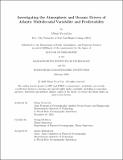Investigating the Atmospheric and Oceanic Drivers of Atlantic Multidecadal Variability and Predictability
Author(s)
Liu, Glenn Yu-zu
DownloadThesis PDF (82.10Mb)
Advisor
Kwon, Young-Oh
Terms of use
Metadata
Show full item recordAbstract
Despite its numerous impacts across the Earth system, the relative importance of ocean and atmospheric dynamics in generating Atlantic Multidecadal Variability (AMV) remains an open question. This thesis presents three pathways to understanding how oceanic and atmospheric processes generate key spatio-temporal signatures of AMV through a combination of processed-based and data-driven approaches. Part 1 (Chapter 2) takes a "bottom up" approach, building a hierarchy of stochastic models to identify the contributions of vertical entrainment and seasonality in local upper-ocean processes to sea surface temperature (SST) variability. Through this hierarchy, I highlight unrealistic features present in slab ocean models widely used to isolate atmospheric contributions to AMV. On the opposite end of the spectrum, Part 2 (Chapter 3) utilizes a "top-down" data-driven approach where deep neural networks are trained to predict the North Atlantic SST Index in both the Community Earth System Model 1 Large Ensemble (CESM1) and observation-based datasets using atmospheric and oceanic predictors. I apply explainable artificial intelligence techniques to highlight a significant source of multidecadal predictability over the Transition Zone in oceanic predictors such as sea surface salinity (SSS) and sea surface height in the presence of external forcings. Part 3 (Chapter 4) returns to the process-based hierarchy, but applies this to understanding SSS variability. The stochastic salinity model is used to investigate the role of mixed-layer re-emergence, subsurface ocean damping and SST-evaporation feedback in shaping the pattern and amplitude of AMV.
Date issued
2025-02Department
Massachusetts Institute of Technology. Department of Earth, Atmospheric, and Planetary SciencesPublisher
Massachusetts Institute of Technology